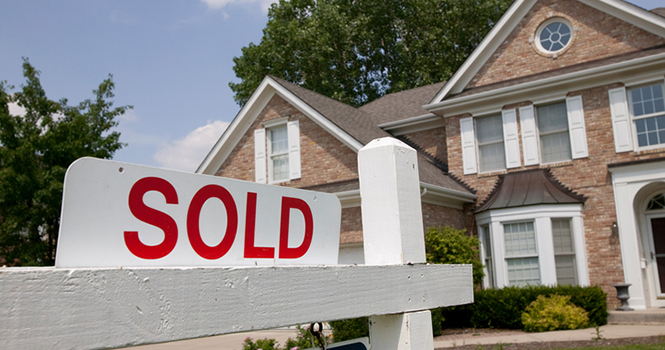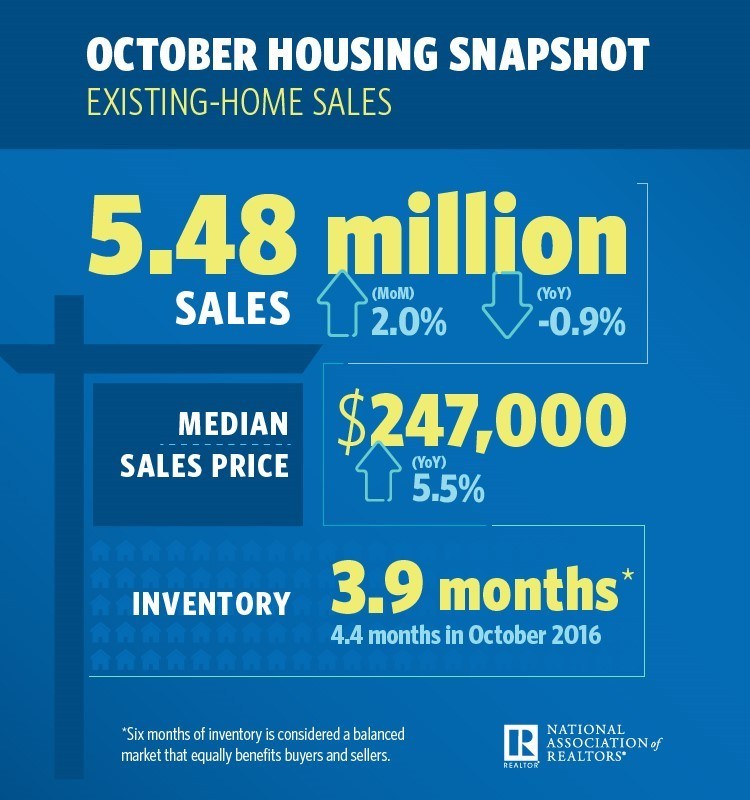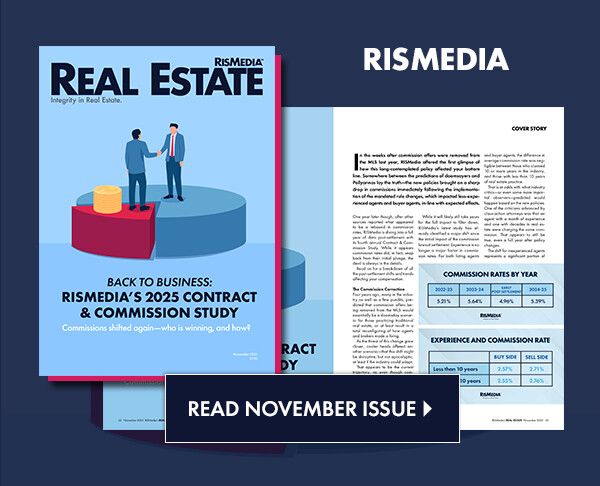Existing-home sales in October were at a pace not seen since summer, the National Association of REALTORS® (NAR) reports.
Existing-home sales totaled 5.48 million, a 2.0 percent increase from September but a 0.9 percent decrease from one year prior. Inventory decreased 3.2 percent to 1.80 million, 10.4 percent below one year prior.
“Job growth in most of the country continues to carry on at a robust level and is starting to slowly push up wages, which is in turn giving households added assurance that now is a good time to buy a home,” says Lawrence Yun, chief economist of NAR. “While the housing market gained a little more momentum last month, sales are still below year-ago levels because low inventory is limiting choices for prospective buyers and keeping price growth elevated.”
Inventory is currently at a 3.9-month supply. Existing homes averaged 34 days on market in October, seven days less than one year prior. All told, 47 percent of homes sold in October were on the market for less than one month.
“Existing-home sales showed another pick up in momentum from September to October, but compared to a year ago, sales were lower for the second time since July 2016,” says Danielle Hale, chief economist at realtor.com®. “Inventories continue to drop from one year ago, creating challenges for buyers across the country. One reason sales were likely able to pick up in September is the increase in new listings available to home shoppers. Realtor.com data show that in spite of declines in overall listings, new listings have increased from a year ago in four of the last five months.”
The metropolitan areas with the fewest days on market and most realtor.com views in October, according to realtor.com’s Market Hotness Index, were San Jose-Sunnyvale-Santa Clara, Calif.; Vallejo-Fairfield, Calif.; San Francisco-Oakland-Hayward, Calif.; San Diego-Carlsbad, Calif.; and Boston-Cambridge-Newton, Mass.
“Listings—especially those in the affordable price range—continue to go under contract typically a week faster than a year ago, and even quicker in many areas where healthy job markets are driving sustained demand for buying,” Yun says. “With the seasonal decline in inventory beginning to occur in most markets, prospective buyers will likely continue to see competitive conditions through the winter.”
The median existing-home price for all types of houses (single-family, condo, co-op and townhome) was $247,000, a 5.5 percent increase from one year prior. The median price for an existing single-family home was $248,300, while the median price for an existing condo was $236,800.
Single-family existing-home sales came in at 4.87 million in October, a 2.1 percent increase from 4.77 million in September, but a 1.0 percent decrease from 4.92 million one year prior. Existing-condo and -co-op sales came in at 610,000, a 1.7 percent increase from September, but no different from one year prior.
Twenty percent of existing-home sales in October were all-cash, with 13 percent by individual investors. Four percent were distressed.
All four major regions saw positive activity in October, with existing-home sales rising 4.2 percent to 740,000 in the Northeast, with a median price of $272,800; 2.4 percent to 1.27 million in the West, with a median price of $375,100; 1.9 percent to 2.16 million in the South, with a median price of $214,900; and 0.8 percent to 1.31 million in the Midwest, with a median price of $194,700.
“The residual effects on sales from Hurricanes Harvey and Irma are still seen in parts of Texas and Florida,” says Yun. “However, sales should completely bounce back to their pre-storm levels by the end of the year, as demand for buying in these areas was very strong before the storms.”
First-time homebuyers comprised 32 percent of existing-home sales in October, an increase from 29 percent in September.
According to NAR President Elizabeth Mendenhall, existing-home sales and the health of the market—and homeownership overall—is threatened by tax reform.
“Making changes to the mortgage interest deduction, eliminating or capping the deduction for state and local taxes and modifying the rules on capital gains exemptions poses serious harm to millions of homeowners and future buyers,” says Mendenhall. “With first-time buyers struggling to reach the market, Congress should not be creating disincentives to buy and sell a home. Furthermore, adding $1.5 trillion to the national debt will raise future borrowing costs for our children and grandchildren.”
For more information, please visit www.nar.realtor.
For the latest real estate news and trends, bookmark RISMedia.com.












